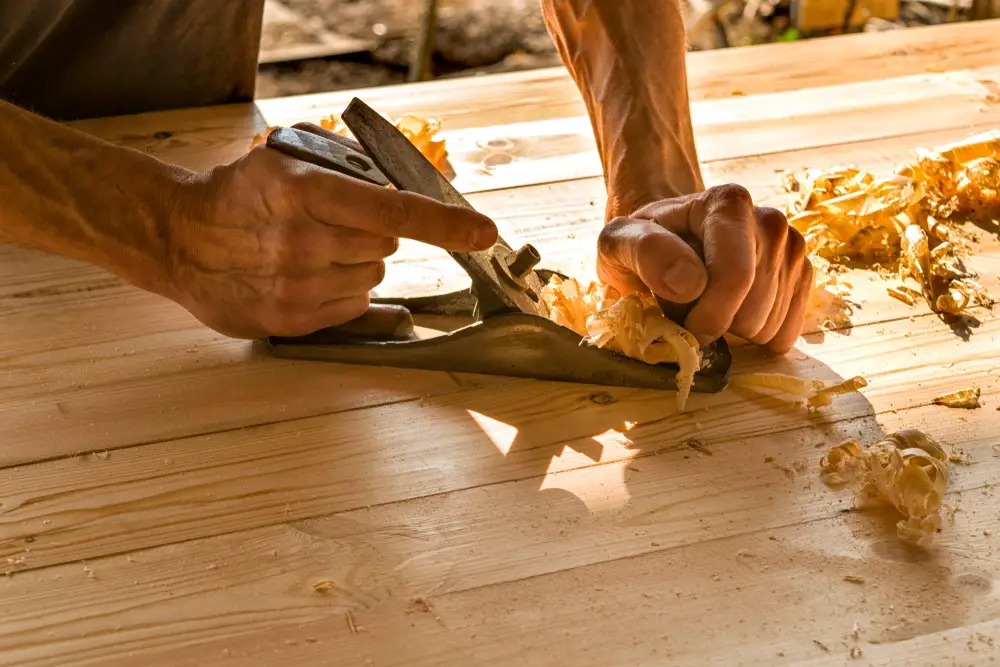Hand planers are primarily designed for sanding and smoothing surfaces. They are also used to produce horizontal, vertical, or inclined flat surfaces on workpieces too large to shape. Hand planes are a combination of cutting edge, usually a sharpened metal plate, traditionally attached to a firm body, which, when moved on a wooden surface, shaves off wood to create a smooth surface.
It has a cutter that extends below the bottom surface, which slices off the wood shavings. The extensive flat sole guides the cutter to remove the high points of an imperfect surface, leaving the workpiece flat and smooth.
There are two types of hand planers: the traditional manual hand planer and the motorized hand planers. The latter is ideal for large-scale planing but unsuitable for fine scale planing where the conventional planer is used. Here’s an in-depth overview of the uses of hand planers:
History of the Hand Planer
Planers have been a woodworking staple for thousands of years. Relics are believed to have been collected from archeological sites in Germany and Britain, and they are very similar to modern hand planers. Also, archeologists found furniture in Egyptian tombs showing evidence of having been planed.
Most traditional hand planers had an iron core surrounded by wood and an iron blade that was secured with a wedge. It is this blade that flattened, smoothed, and leveled wood surfaces. Then, in the 19th century, Leonard Bailey began producing cast iron hand planers. His design became the blueprint of modern hand planes.
Later, Stanley Rule & Level company purchased Bailey’s patents committing to produce the hand planers on a large-scale. Still known as Stanley Works, the company has since produced beautiful planers with wooden bodies.
Many features of Bailey’s design linger even in modern hand planers though different designs have been developed since then to cater to different woodworking uses. The standard model is the bench planer an umbrella name for:
- The scrub plane: It removes large amounts of wood quickly. It has a wide mouth opening that accommodates thick chips or shavings
- Jointer plane: This kind is used for flattening and jointing boards
- Polishing plane: They are used to create a smooth finish on wood pieces
- Jack plane: It roughs out wood pieces but with more accuracy
- Smoothing plane: Prepares the surface for finishing
- Molding plane: Cuts moldings along the edge of the board
What Are Planers Used For?
Sanding
The planers are compatible with multiple blades, which makes it easy to choose from one blade to another. Reusable high-speed steel blades are used for making shallow cuts on wooden surfaces and sanding.
The traditional model is more appropriate for sanding long, thick boards as they allow maximum control and application of uniform pressure. For small, localized sanding jobs, however, you can use a power planer as it is more efficient than the belt sander.
Chamfering
It is a process that allows you to place glass panels or thin wooden boards perpendicular to the chamfer. Most power planers have this feature letting woodworkers dig chamfers in wood pieces. When buying a hand planer, inquire if it has such capabilities if your projects need it.
Restoration of Wood pieces
If your workpiece is littered with knots or bug holes, then you want to use a hand planer to remove the blemishes. However, if the gouges are deeply ingrained in the wood, then a hand planer should not be your tool of choice. The device is primarily designed to remove thin layers of timber, usually between 0-0.125 inches thick.
Taking out Wood
A scrub plane is ideal for this application. It removes wood from the workpiece, usually more than a single pass of any plane. You can use other types of planes, but the scrub plane is more effective. Since the plane takes out a lot of wood material in a single pass, it may leave chewed up edges of wood hence not ideal for making finishes unless you want to create a rustic look.
Tapering
Cabinets need several boards cut in a way that it allows the ends fit with the connecting board. You can make several passes over one end of the board using a hand plane until you have attained the desired thickness. You just need to adjust the cutting depth to avoid going beyond what the project requires.
Making Emergency Repairs
Too much moisture causes doors and cabinets to creak. You can run a planer along the hinge-less side of the door to solve the problem.
Smoothing
A hand plane smooths out wood surfaces, and this is usually done using a smoothing plane. The plane creates a smooth surface which is smoother than when using a sander. The smoothing process is one of the last steps when working on a workpiece.


